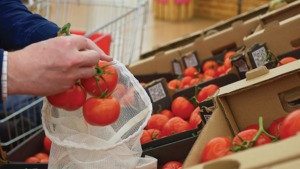Produce packaging playing active role in food safety
The produce industry works hard at delivering safe food. Unfortunately, those efforts are not 100% effective.
As a result, the U.S. Food and Drug Administration (FDA) issued numerous recalls in 2023 due to suspected pathogenic contamination, generally attributed to a strain of listeria or salmonella. Recalled produce included whole cantaloupes, fresh-cut fruit, premade salads, enoki mushrooms, bean sprouts and fresh diced onions.

The FDA has recently implemented numerous produce handling and traceability rules to enhance food safety. Packaging and automated processes can help produce processors comply with these requirements.
The FDA recently published the first in an educational video series about how tech-enabled traceability can enhance food safety and help prevent foodborne illness. The first episode focuses on supply chain technology and builds on key themes from the 2021 FDA New Era of Smarter Food Safety Low- or No-Cost Tech-Enabled Traceability Challenge.
The video describes approaches to low- or no-cost traceability technologies and shows how a digital, efficient and safe food system can benefit consumers and food producers. Participants also discuss opportunities to voluntarily adopt tracing technologies and harmonize tracing activities, as well as ways to incentivize the development and implementation of scalable and cost-effective traceability hardware, software or data analytics platforms.
DIGITAL TECH ADVANCES
When automation supports traceability and food safety measures, it often involves a packaging line component such as advanced code printing, code scanning and data capture. This equipment is continuously evolving to be more efficient. New codes like the two- dimensional (2D) GS1 Digital Link can offer functionality for all points in the supply chain.
Designed to replace the standard one-dimensional Universal Product Code on product packages, the Digital Link code carries additional data to link to information needed by various stakeholders. This includes product information, expiration dates and package disposal instructions for consumers as well as information needed by retailers, warehouses and logistics providers. When adopted, it could play an important role in product traceability.
GS1, the barcode standards organization, has already developed a standard for the new code, and the latest barcode printers are being designed to accommodate it. A GS1 Sunrise 2027 program has been launched to help prepare the industry to be able to accept 2D barcodes at point-of-sale by 2027.

PACKAGING PROTECTION
Packaging plays a vital role in food safety by protecting produce products from contamination, spoilage and damage. Historically, packaging has served as a passive barrier, but more recently, active options have begun to appear on the market. This includes antimicrobial and shelf-life-extending films and modified atmospheres.
Active packaging is being developed to discourage microbial activity, retard oxidation, scavenge ethylene, change color to indicate spoilage and/or provide a tailored barrier to water vapor and gas transmission. In some cases, these new materials enhance product quality and freshness and meet sustainability objectives, such as decreasing reliance on plastic packaging derived from fossil fuels. Renewable packaging materials may be starch-, fiber-, vegetable- or animal-based and may involve antimicrobial additives such as silver.
In fact, the renewable and highly recyclable nature of fiber-based paper and paperboard packaging materials is expected to help drive a 4.6% compound annual growth rate for this produce packaging segment between 2022 and 2031, according to a report from Allied Market Research, Produce Packaging Market.
Innovations in product protection and traceability were displayed at PACK EXPO East 2024, held March 18-20 at the Pennsylvania Convention Center in Philadelphia. The 2024 edition, the largest to date, featured more than 500 exhibitors and 100,000 net square feet of exhibit space offering crossover manufacturing solutions for more than 40 vertical markets.
Tom Egan serves as the vice president of Industry Services for PMMI, the Association for Packaging and Processing Technologies. He joined PMMI in 2003 following more than 20 years in the packaging industry during which he was also an active PMMI member.







